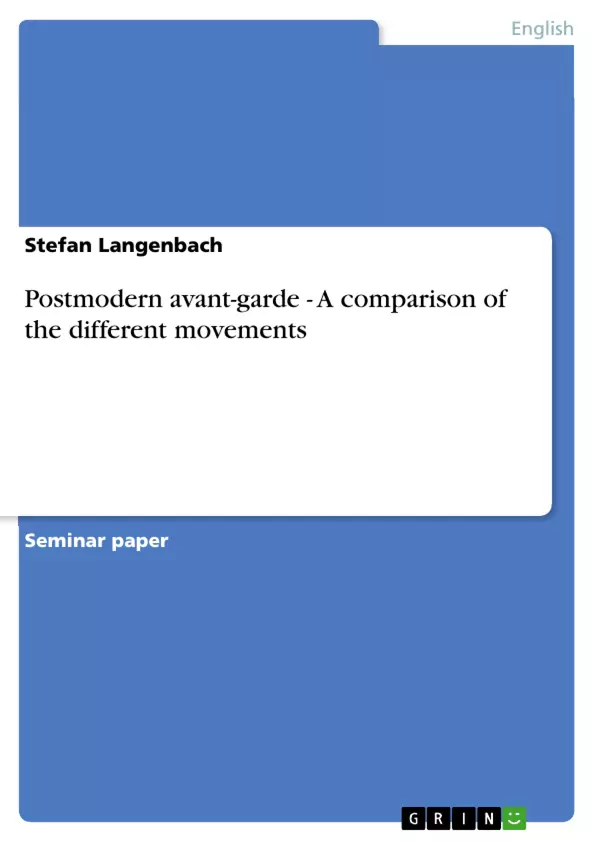This term-paper was prepared in order to show the different poetic movements of the postmodern
avant-garde. These are known under the names “Black Mountain school”, “San
Francisco Renaissance”, “Beat-generation” and ” New York School” and began in the 1950s
in America.
My term-paper will show the development of these different poetic movements, give an
understanding of the most important poets of each movement and explain if and how the
different movements are linked to each other and what they have in common.
From the middle of the 1950s up to the early years of the 1960s the world of American poetry was divided into two different groups. One of these groups represented the lyrical mainstream while the other group saw themselves as a kind of counterculture. The idols of this group where William Carlos Williams, Ezra Pound, Louis Zukofsky and Gertrude Stein. By the beginning of the 1950s this new way of writing, which was called postmodern avant-garde, was just in the beginning years. In 1960 the anthology New American Poetry was published by Grove Press and brought together many writers of this new poetic line for the first time.
Inhaltsverzeichnis (Table of Contents)
- I. Introduction
- II. Postmodern avant-garde
- III. Black Mountain School
- 1.) Development
- 2.) Artists
- 3.) Example
- 4.) Short Analysis
- IV. San Francisco Renaissance
- 1.) Development
- 2.) Artists
- 3.) Example
- 4.) Short Analysis
- V. Beat-generation
- 1.) Development
- 2.) Artists
- 3.) Example
- 4.) Short Analysis
- VI. New York School
- 1.) Development
- 2.) Artists
- 3.) Example
- 4.) Short Analysis
Zielsetzung und Themenschwerpunkte (Objectives and Key Themes)
This term paper aims to explore the different poetic movements of the postmodern avant-garde in America during the 1950s. It will delve into the development of these movements, including the "Black Mountain School," "San Francisco Renaissance," "Beat-generation," and "New York School." The paper will also analyze the key poets associated with each movement and their contributions to the broader literary landscape. Key themes explored in the paper include:- The emergence of a distinct counterculture within the world of American poetry.
- The influence of key figures such as William Carlos Williams, Ezra Pound, Louis Zukofsky, and Gertrude Stein.
- The impact of experimental writing and its departure from traditional lyrical approaches.
- The development of unique poetic styles, such as the "projective verse" movement.
- The interconnectedness of different movements and the role of key figures in bridging them.
Zusammenfassung der Kapitel (Chapter Summaries)
- Introduction: This chapter provides an overview of the paper's goals and outlines the four main postmodern avant-garde poetic movements that will be examined.
- Postmodern Avant-garde: This chapter explores the emergence of the postmodern avant-garde movement in American poetry in the 1950s. It discusses the countercultural nature of this movement and its key influences.
- Black Mountain School: This chapter focuses on the Black Mountain School, a group of American postmodern poets centered around Black Mountain College. It examines the school's origins, its emphasis on creative arts, and the development of the "projective verse" style.
- San Francisco Renaissance: This chapter delves into the San Francisco Renaissance, exploring its connections to the Black Mountain School and its key poets. It analyzes the stylistic characteristics of this movement and its impact on American poetry.
- Beat-generation: This chapter examines the Beat generation and its close connection to the San Francisco Renaissance. It highlights the key figures of this movement and the unique qualities of their writing style.
- New York School: This chapter focuses on the New York School of poetry, outlining its origins, its key poets, and its distinctive style. It explores the evolution of this movement and its place within the larger landscape of postmodern American poetry.
Schlüsselwörter (Keywords)
The central themes and concepts explored in this paper include postmodern avant-garde, Black Mountain School, San Francisco Renaissance, Beat-generation, New York School, projective verse, experimental poetry, counterculture, William Carlos Williams, Ezra Pound, Louis Zukofsky, Gertrude Stein, and influential poets such as Charles Olson, Robert Creeley, and Allen Ginsberg.- Quote paper
- Stefan Langenbach (Author), 2006, Postmodern avant-garde - A comparison of the different movements, Munich, GRIN Verlag, https://www.grin.com/document/88592



